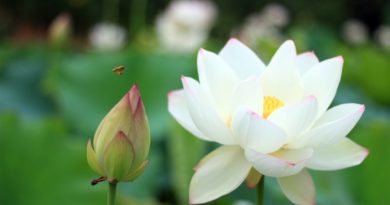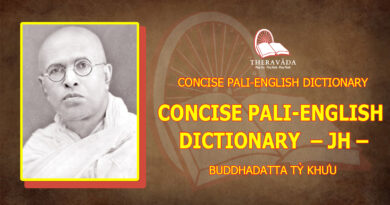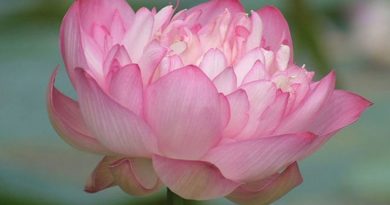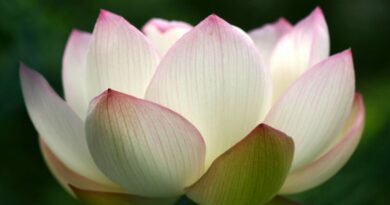FUNDAMENTALS OF VIPASSANA MEDITATION – CHAPTER I & II
FUNDAMENTALS OF VIPASSANA MEDITATION
CHAPTER I: Calm And Insight
What do we meditate on? How do we develop insight? This is a very important question.
There are two kinds of meditation: meditating to develop calm and meditating to develop insight. Meditating on the ten devices only gives rises to calm, not insight. Meditating on the ten foul things (a swollen corpse, for example), too, only gives rise to calm, not insight. The ten recollections, like remembering the Buddha, the Law and others, too, can develop calm and not insight. Meditating on the thirty two parts of the body, like hair, nails, teeth, skin – these too, are not insight. They develop only concentration.
Mindfulness as to respiration is also concentration developing, but one can develop insight from it. Visuddhi Magga, however, includes it in the concentration subjects and so we will call it as such here.
Then there are the four divine states, love, pity, sympathetic joy, and equanimity, and four formless states leading to formless jhanas. Then, there is the meditation on the loathsomeness of food. All these are subjects for concentration meditation.
When you meditate on the four elements inside your body, it is called the analysis of the four elements. Although this is a concentration meditation, it helps develop insight as well.
All these forty subjects of meditation are subjects for developing concentration. Only respiration and analysis of elements have to do with insight. The others will not give rise to insight. If you want insight, you will have to work further.
To come back to our question, how do we develop insight? The answer is: we develop insight by meditating on the five aggregates of grasping. The mental and material qualities inside beings are aggregates of grasping. They may be grasped with delight by craving in which case it is called “grasping of the sense objects” – or they may be grasped wrongly by wrong views – in which case it is called “grasping through wrong views.” You have to meditate on them and see them as they really are. If you dont, you will grasp them with craving and wrong views. Once you see them as they are, you no longer grasp them. In this way you develop insight. We will discuss the five aggregates of grasping in detail.
CHAPTER II: Aggregates
The five aggregates of grasping are matter or form, feelings, perception, volitional activities and consciousness. What are they? They are the things you experience all the time. You do not have to go anywhere else to find them. They are in you. When you see, they are there in the seeing. When you hear, they are there in the hearing. When you smell, taste, touch, or think, they are there in the smelling, tasting, touching or thinking. When you bend, stretch or move your limbs, the aggregates are there in the bending, stretching or moving. Only you do not know them to be aggregates. It is because you have not meditated on them and so do not know them as they really are. Not knowing them as they are, you grasp them with craving and wrong view.
What happens when you bend? It begins with the intention to bend. Then come the forms of bending one by one. Now in the intention to bend there are the four mental aggregates. The mind that intends to bend is the consciousness. When you think of bending and then bend, you may feel happy, or unhappy, or neither happy nor unhappy, doing so. If you bend with happiness, there is pleasant feeling. If you bend with unhappiness or anger, there is unpleasant feeling. If you bend with neither happiness nor unhappiness, there is neutral feeling. So, when you think of bending, there is the feeling aggregate.
Then, there is perception, the aggregate that recognises the bending. Then, there is the mental state that urges you to bend. It seems as though it were saying “Bend! Bend!” It is the volitional activities. Thus, in the intention to bend, you have feelings, perception, volitional activities and consciousness – all four mental aggregates. The movement of bending is matter or form. It is the material aggregate. So, the intention to bend and the bending together make up the five aggregates.
Thus, in one bending of the arm, there are the five aggregates. You move once and the five aggregates come up. You move again and there are more of the five aggregates. Every move calls up the five aggregates. If you have not meditated on them rightly and have not known them rightly, what happens we need not tell you. You know yourselves.
Well, you think “I intend to bend” and “I bend”, dont you? Everybody does. Ask the children, they will give the same answer. Ask adults who cant read and write, the same answer. Ask someone who can read, the same answer still if he will say what he has in his mind. But, because he is well read, he may invent answers to suit the scriptures and say “Mind and matter.” It is not what he knows for himself. Only inventions to suit the scriptures. In his heart of hearts he is thinking “It is I who intend to bend. It is I who bend. It is I who intend to move. It is I who move.” He also thinks: “This I have been before, am now, and will be in future. I exist for ever.” This thinking is called the notion of permanence. Nobody thinks, “This intention to bend exists only now.” Ordinary people always think. “This mind existed before. The same I that have existed before am now thinking of bending.” They also think, “This thinking exists now and will go on existing.”
When you bend or move the limbs, you think: “It is the same limbs that have existed that are moving now. It is the same I that have existed that am moving now.” After moving you again think, “These limbs, this I, always exist.” It never occurs to you that they pass away. This, too, is the notion of permanence. It is clinging to what is impermanent as permanent, clinging to what is no personality, no ego, as personality, as ego.
Then, as you have bent or stretched to your desire, you think it is very nice. For example, as you feel stiffness in the arm, you move or rearrange it and the stiffness is gone. You feel comfortable. You think it is very nice, you think it is happiness. Dancers and amateur dancers bend and stretch as they dance and think it is very nice to do so. They delight in it and are pleased with themselves. When you converse among yourselves you often shake your hands and heads and are pleased. You think it is happiness.
When something you are doing meets with success, again you think it is good, it is happiness. This is how you delight through craving and cling to things. What is impermanent you take to be permanent and delight in. What is not happiness, not personality, but just aggregates of mind and matter, you take to be happiness, or personality, and delight in. You delight in them and cling to them. You mistake them for self or ego and cling to them, too.
So, when you bend, stretch or move your limbs, the thinking “I will bend” is aggregate of grasping. The bending is the aggregate of grasping. The thinking “I will stretch” is the aggregate of grasping. The stretching is the aggregate of grasping. The thinking “I will move” is the aggregate of grasping. The moving is the aggregate of grasping. When we speak of aggregates of grasping to be meditated on, we mean just these things.
The same thing happens in seeing, hearing, etc. When you see, the seat of seeing, the eye, is manifest. So is object seen. Both are material things. They cannot cognize. But if one fails to meditate while seeing, one grasps them. One thinks the whole body with the eye is permanent, happy, self, and grasps it. One thinks the whole material world with the object seen is permanent, beautiful, good, happy, and self, and grasps it. So the form eye and the form visible objects are aggregates of grasping.
And when you see, the “seeing” is manifest, too. It is the four mental aggregates. The mere awareness of seeing is the aggregate consciousness. Pleasure or displeasure at seeing is the aggregate feeling, What perceives the object seen is the aggregate perception. What brings the attention to see is the aggregate volitional activities. They constitute the four mental aggregates. If one fails to meditate while seeing, one is inclined to think that seeing “has existed before, and exists now.” Or, as one sees good things, one may think “seeing is good.” So thinking, one goes after good and strange things to enjoy seeing. One goes to watch films at the expense of money, sleep because one thinks it is good to do so. If one does not think it is good, one will not go to waste money or impair ones health. To think that what sees or enjoys is I, I am enjoying, is to grasp with craving and wrong view. Because they grasp, the mind and matter that manifest themselves in seeing are said to be aggregates of grasping.
You grasp in the same way in hearing, smelling, tasting, touching or thinking. You grasp all the more to the mind that thinks, imagines and reflects as being the I, the ego. So, the five aggregates of grasping are none other than the mental material things that manifest themselves at the six doors whenever one sees, hears, feels or perceives. You must try to see these aggregates as they are. To meditate on them and see them as they are – that is insight knowledge.









